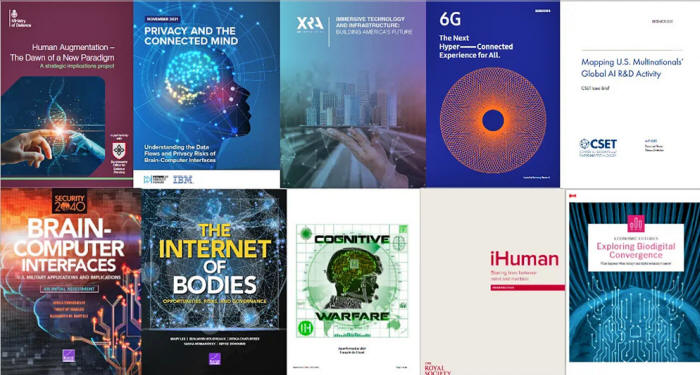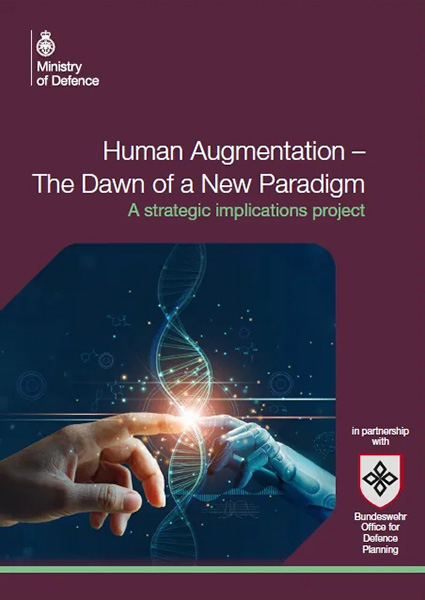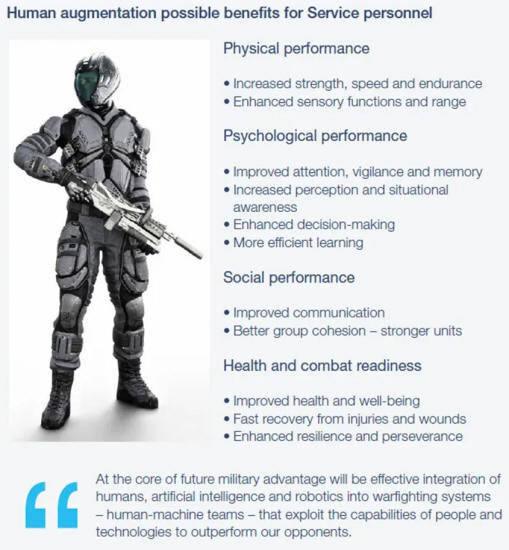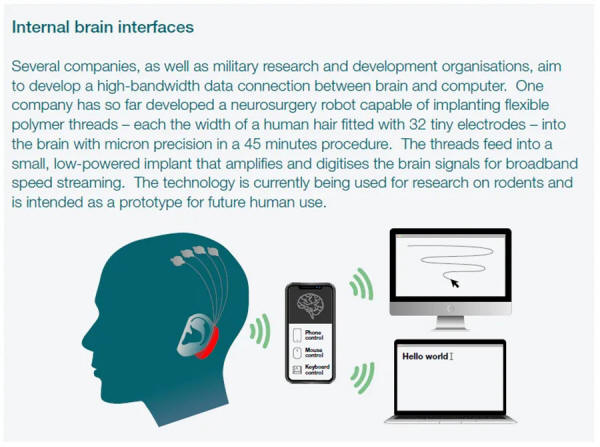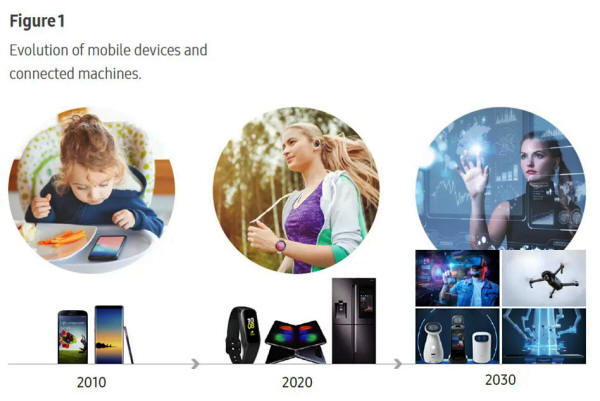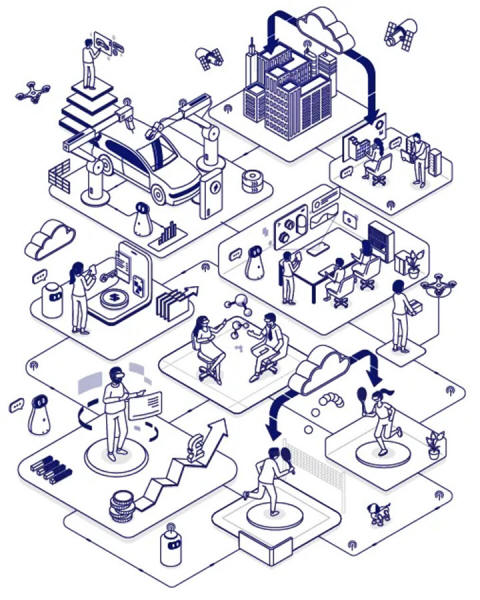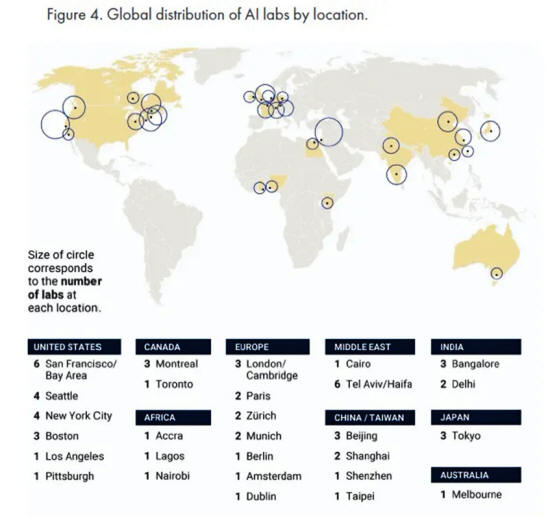|
from
JoeBot Website
describe the hell that technocrats
are taking us
to...
PART 2 HERE...
Shaken by the contagion, otherwise normal
people recoiled from human contact and were forced to become transhuman screen-monkeys. As the
New Normal intensified, this
dependence became a feature, not a bug.
Yet in these ten documents, published between 2019 and 2021, we see an open embrace of transhumanist ideas by,
The concept of "transitional humans" hurtling toward a technological Singularity unfolds on three levels.
In the
20th century, the emergence of
artificial life - silicon-based digital
beings - opened bizarre possibilities.
The documents below chart that convergence, each from a different angle.
One after another, they confront the total transformation of
human beings through technology. Cyborgs are already among us, and
commercial brain-computer interfaces (BCI) loom just over the
horizon.
As you'll see, that door is wide open...
Download PDF here
Transhumanist ambitions are made possible by military technology.
In the 1960's, the first serious efforts to create a brain-computer interface were funded by the U.S. Defence Advanced Research Projects Agency (DARPA).
Two decades later, the Internet was developed to make communication lines redundant in case of nuclear war.
'Human Augmentation - A New Paradigm', commissioned by the UK's Ministry of Defense, follows various technological threads to their logical conclusions.
A central goal is to merge minds with machines in an intimate human-AI symbiosis:
Beyond cyborg super soldiers, the principle of transcending human limitation through technology is also being applied to civilian populations.
One critical concept is that standard tools and transformative technologies - from the abacus to smartphones to brain implants - exist on a spectrum.
Page 72
In the curiously prescient image below, we see a man using an implanted BCI to type "Hello world" onscreen. Keep in mind, this document was published in May of 2021.
Eight months later, an actual paralyzed man used his Stentrode implant - developed by Synchron - to send the first tweet using only the brain.
His message?
In a follow-up tweet, the patient said:
Page 48
Imagine receiving neuro-enhancement that could rid you of bigotry, or suspicion, or even your warped sense of humor.
If "diversity is our strength," then a polyglot, digitally enhanced super-organism will be unassailable:
Considering the rise of biosecurity states across the globe, an especially horrific aspect of Human Augmentation is the comparison of anti-cyborg sentiments to vaccine hesitancy:
Of course, no review of our cyborg future would be complete without indie bio-hacking.
According to the implant company Dangerous Things, anywhere from 50,000 to 100,000 people already have digital bio-implants in their bodies.
Perhaps inspired by biblical prophecy, many of these are RFID chips embedded in the hand:
From chipped hands to chipped heads, the Cyborg Age has arrived...
As with many innovations - virtual reality, neuro-implants, smartphone components - the technologies first developed in military labs are gradually diffusing into our day-to-day lives.
2 - IBM - Privacy and the Connected Mind (2021)
Download PDF here [h/t Phil Gibson @PezntJournalist]
All of these ten documents contain a mixture of breathless enthusiasm and dire warnings.
On balance, IBM errs on the side of caution. A brain-computer interface could lead to unprecedented psychological surveillance and mind control by authorities.
Beyond that, the danger of having your brain hacked are quite real.
Still, the authors' dry description of BCI applications - both invasive implants and non-invasive skull caps - sends a chill down the spine. Imagine a world where drooling kids play video games using only their brains.
On an institutional level, imagine schoolchildren forced to wear brain-monitoring headbands in classrooms.
Imagine having to wear a skull-cap at work, or even just during the hiring process. Imagine all that neurological data being gathered, analyzed, and used by corporations to sell you better iTrodes.
Freaked out? Imagine undergoing transcranial stimulation to put you at ease with the whole situation.
According to IBM's analysts, those scenarios are just over the horizon:
Page 5
Remember, having mandatory electrodes jabbed into your skull is not the most pressing concern. At least, I hope not...
A more immediate problem is the normalization and mass implementation of non-invasive brain technologies.
There are already high-end BCI helmets on the market, such as Kernel Flow.
When they get cheaper to manufacture and deploy, you'll start seeing them everywhere.
3 - XRA - Immersive Technology and Infrastructure (2021)
Download PDF here.
Facebook made waves when Mark Zuckerberg laid claim to his corner of the Metaverse, but it hardly started with him. This is a concerted effort to place screens over every pair of eyes on the planet.
The XR Association is a flashpoint for this movement.
The organization was founded in 2016 to promote virtual reality, augmented reality, and mixed reality.
Today, members include by,
...and a number of other tech corporations.
The goal is to normalize the Metaverse in business and industry.
Without shame, the XRA openly promotes 'The Fourth Industrial Revolution' as conceived by Klaus Schwab and the WEF:
Page 1
In the months after Immersive Technology and Infrastructure was published, capital has poured into countless Metaverse projects.
It's not hard to imagine workers of the future wearing VR goggles on their faces that match the BCI helmets on their heads. If you thought hard hats and hi-viz vests were annoying, you aren't seen nothing yet.
One argument for stuffing Westerners into a phony virtual realm is to keep up with progress being made in the East.
This is often urged from a military standpoint, but the concept extends to the wider economic landscape as well:
One sure fire way to "future proof" society is to assimilate every individual into the MetaBorg. If it's good enough for China, it's good enough for you.
4 - Samsung - 6G: The Next Hyper-Connected Experience for All (2020)
Download PDF here
The notion of "smart cities" unnerves a lot of people, and for good reason.
A smart city has cameras around every corner and digital sensors embedded in pretty much everything, from your car to your sink faucet.
This interconnected network - linked through the ghoulish Internet of Things - requires massive data flow from device to device. 5G networks are needed to glue any digital termite colony together.
Even now, across Asia and elsewhere, plans are being laid for the 6G revolution.
In this Samsung white paper, we witness milestones in the life of a blonde South Korean digital native - from primitive 4G to modern 5G to ultra-smart 6G.
Page 10
As a wee babe in 2010, she became dependent on her glowing smartphone.
By 2020, she's an independent woman whose physical being is monitored by wearable devices. Through earbuds, her consciousness is tuned by sensory augmentation.
Even her fridge is smart enough to keep tabs on her.
By 2030, her whole consciousness will be shaped by 6G-powered augmented reality.
But it'll take a sprawling 6G wireless infrastructure to build her humming smart city and cozy smart home:
Part of this "connectedness" and "openness" is having every element of your life recorded and replicated in virtual space.
Using that information, corporations and governments can construct a virtual model of your entire being, inside and out. They can anticipate your wants and behaviors, and provide just the right stimulus to keep you in line.
These "digital twins" can then be studied and manipulated in virtual space - soul clones to be played with like dolls:
Come the revolution, augmented humans will live in a technocratic paradise.
We'll be like wingless eusocial angels, crawling around our 6G-powered termite mound.
Page 2
5 - CSET - Mapping U.S. Multinationals' Global AI R&D Activity (2020)
Download PDF here
Artificial general intelligence is the holy grail for transhumanists.
The human brain is limited, and there's only so many smart drugs and iTrodes you can cram in your head. To get past that cognitive limit, it's believed, we'll need vast AI systems to do the hard thinking for us.
In fact, nearly every paper in this collection notes that human augmentation is the bridge between the feeble human brain and advanced AI.
But,
Mapping U.S. Multinationals' Global AI R&D Activity tracks six Big Tech firms across the world.
Interestingly, most of the experimental work is done overseas.
From the executive summary:
This international market, along with a pliable foreign labor force, provides an explanation for why Silicon Valley and Seattle are so keen on open borders.
To Big Tech, the world is one big pile of data (and dollars) waiting to be sucked up into The Machine.
According to this report, the "number of public AI labs by company" is:
After seeing the meteoric rise of Google's DeepMind project - based in the UK - it's no surprise they dominate the field.
Microsoft is coming up behind them fast, though, and IBM's Watson is legendary.
While most personnel are based in the U.S. (68%), most of the actual labs are operated overseas (also 68%). Why? Cheap labor, obviously.
But one wonders if AI companies aren't also attracted by lax ethical constraints. The paper doesn't say...
As if their seeds were scattered by the four winds, American AI labs have sprouted up across the globe. Many are unaware of this, but Nigeria is a hot spot for computer programmers.
On the other hand, an alarming number of American AI labs currently operate in China. Google and IBM both have a lab there. Of Microsoft's twenty labs, four are in China.
If you ever wondered how communists came up the ingenious TikTok algorithms to ensare the 'Merican mind, wonder no more.
Pandas learn fast...
Page 14
Coincidentally, in the 2019 Netflix documentary Inside Bill's Brain - Decoding Bill Gates, the last episode centers on Gates's experimental nuclear power plants in China.
The series ends with Gates bummed out that Trump's aggressive policies threw a monkey wrench into his China projects.
These days, Elon Musk is doing great over there.
Chinese collusion aside, the four "American" corporations tracked above have AI headquarters all over the world:
The top AI labs in the East are:
The top AI labs in the US:
The top AI labs in Canada:
The top AI labs in Europe:
And don't forget the international operations of Ben "Squirrel-Herder" Goertzel and David "Robo-Lover" Hanson:
Download PDF here.
PART 2 HERE...
|


